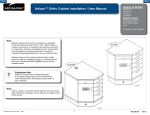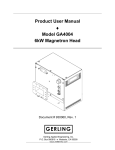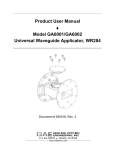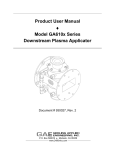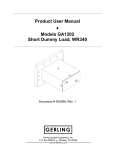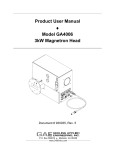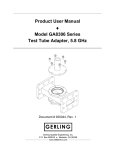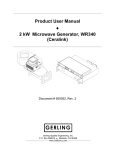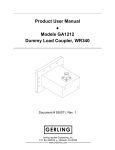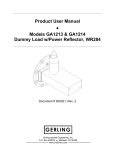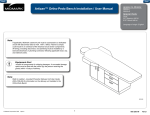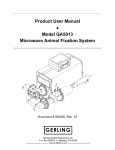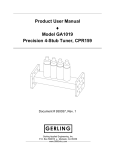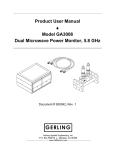Download Product User Manual Model GA101x Series High Power E
Transcript
Product User Manual ♦ Model GA101x Series High Power E-H Tuner Document # 930024, Rev. 2 P.O. Box 580816 ♦ Modesto, CA 95358 www.2450mhz.com Product User Manual Model GA101x Series High Power E-H Tuner REV. 2 REVISION HISTORY DESCRIPTION Misc. updates, corrections Page 2 DATE 29APR03 APPROVAL JFG WARRANTY Products manufactured and sold by Gerling Applied Engineering, Inc. (“GAE”) are warranted to be free of defects in materials and workmanship under normal use and service for a period of twelve (12) months from the date of original shipment. GAE’s obligation under this warranty is limited to repairing or replacing, at GAE’s option, all non-consumable component parts. Consumable parts are specifically excluded from this warranty and may include, but are not be limited to, magnetrons, fuses, lamps, seals, o-rings, v-belts, and fluids. All warranty repairs are to be done at GAE’s facility or as otherwise authorized by GAE. All shipping charges for warranty repair or replacement are the purchaser’s responsibility unless otherwise agreed to by GAE. This warranty supercedes all other warranties, expressed or implied. No warranty is given covering the product for any particular purpose other than as covered by the applicable product specifications. GAE assumes no liability in any event for incidental or consequential damages, financial losses, penalties or other losses incurred in conjunction with the use of GAE products. DOCUMENT CONVENTIONS NOTE: Means the reader should take note. Notes contain helpful information, suggestions, or references to other sections, chapters, or documents. CAUTION: Means the reader should be careful. You are doing something that might result in equipment damage or loss of data. WARNING: Means danger. A situation exists that could cause bodily injury or death. All personnel must be aware of the hazards involved with high voltage electrical circuitry and high power microwave devices. 2002-2003 Gerling Applied Engineering, Inc. Modesto, CA Product User Manual Model GA101x Series High Power E-H Tuner Page 3 WARNING All waveguide tuners manufactured by GAE, Inc. are intended for use with other equipment capable of producing a microwave field that is potentially hazardous to operating personnel. They must never be connected or operated in a manner that allows a field in excess of 10 milliwatts per square centimeter to be generated in an area accessible to operating personnel. Contact GAE, Inc. for technical support prior to installation and/or operation of these units if there is any question or concern about microwave leakage. All waveguide flange and electrical cable connections throughout the system must be secure prior to operation. Never operate the microwave generator without a properly rated absorbing load attached. To ensure safe operation and prevent microwave leakage, the equipment must be periodically inspected and maintained as required or recommended. 2002-2003 Gerling Applied Engineering, Inc. Modesto, CA Product User Manual Model GA101x Series High Power E-H Tuner Page 4 TABLE OF CONTENTS EQUIPMENT DESCRIPTION.......................................................................................... 5 General Specifications 5 INSTALLATION .............................................................................................................. 6 Preliminary Inspection Waveguide Configuration Flange Connections Flange Alignment Pins 6 6 6 7 OPERATION ................................................................................................................... 8 Basic Operation Standard Tuning Procedure False Null High Power Operation 8 8 9 9 MAINTENANCE AND CALIBRATION.......................................................................... 10 2002-2003 Gerling Applied Engineering, Inc. Modesto, CA Product User Manual Model GA101x Series High Power E-H Tuner Page 5 EQUIPMENT DESCRIPTION The GA101x series High Power E-H Tuners are designed for load impedance matching in high power microwave heating systems. Sliding plungers inside each waveguide extension are designed with non-metallic (Teflon) contacting surfaces for reduced wear. Reactive chokes within the plunger minimize power losses during high power operation. Two types of tuner design are offered. The economical Basic models (GA1011 thru GA1014) are operated using simple push-rod actuators and feature clamping collars to lock the actuators in the desired positions. The Precision models (GA1015 thru GA1018) feature precision-machined plunger drive mechanisms with multiturn digital readout dials for accurate and repeatable positioning. In both models, the stub housings are designed with 1/4-wave reactive chokes allowing use in high “Q” applications. Construction of these tuners is dip brazed aluminum waveguide, aluminum plungers and brass/stainless steel drive mechanisms. Models GA1014 and GA1018 feature the popular WR284 Q-D (quick-disconnect) round flange that uses the convenient single screw clamp (model GA8401) for waveguide connections. General Specifications Frequency 2450 +/- 50 MHz Basic Models GA1011 GA1012 GA1013 GA1014 Precision Models GA1015 GA1016 GA1017 GA1018 Power 3 kW 6 kW 6 kW 3 kW Waveguide WR284 WR340 WR430 WR284 Flanges UG1725/U UG554/U UG437B/U UG584/U Plunger Travel 4.7 inch 12 cm 3.0 inch 7.6 cm Construction Dip brazed aluminum waveguide and plungers, brass/steel actuator and drive mechanism Finish Clear chemical film on waveguide; Black paint (precision models only) 2002-2003 Gerling Applied Engineering, Inc. 3.5 inch 8.9 cm 4.7 inch 12 cm Modesto, CA Product User Manual Model GA101x Series High Power E-H Tuner Page 6 INSTALLATION Preliminary Inspection Upon arrival at the installation site the tuner should be thoroughly inspected for damage or wear caused during shipping. Any visible damage to the packaging material or the tuner itself should be noted and reported immediately to the shipping company in accordance with standard claims procedures. The following components are included: a) High Power E-H Tuner b) Product User Manual Waveguide Configuration The high power E-H tuner can be connected to and used with any common waveguide component having a compatible flange (see below). Mounting can be in any convenient position and orientation with either flange positioned towards the process load. Ideally, the tuner should be located as close to the process load as possible. Figure 1 illustrates a typical waveguide configuration. Figure 1 – Typical waveguide configuration for process load impedance tuning. Flange Connections Both flanges of the E-H tuner must be properly connected to another waveguide component. Bolts and nuts must be installed at all flange bolt holes on both flanges prior to operation. Model GA1014 is available with flanges designed for used with the 2002-2003 Gerling Applied Engineering, Inc. Modesto, CA Product User Manual Model GA101x Series High Power E-H Tuner Page 7 GA8401 Quick-Release clamp when connected to another similarly designed flange. These flanges can also be connected to any other standard WR284 round flange (UG-584/U) using suitable fastener hardware. Flange Alignment Pins Each waveguide flange connection that uses a quick-release clamp requires two alignment pins for proper alignment of the adjacent waveguide sections. All GAE waveguide components include one alignment pin for each flange designed for use with quick-release clamps. Alignment pins can be installed into either of two threaded holes centered above and below the waveguide broadwalls. For obvious reasons, the pins must not be installed such that they are opposite each other on mating flanges. Microwave Leakage – Regulatory limits for microwave leakage relate to standards for human safety and interference with other electronic devices. Standards for human safety as adopted by OSHA, the International Electrotechnical Commission (IEC) and other regulatory agencies limit leakage to 5 mW/cm2 measured at 5 cm from the leakage source under normal operating conditions, and 10 mW/cm2 at 5 cm from the source under abnormal operating conditions. The U.S. Federal Communications Commission (FCC) has established regulations limiting the emission of energy at frequencies outside the ISM bands. All GAE waveguide components meets these requirements when properly connected to another waveguide component. 2002-2003 Gerling Applied Engineering, Inc. Modesto, CA Product User Manual Model GA101x Series High Power E-H Tuner Page 8 OPERATION Basic Operation The most common intended function of the high power E-H tuners is to provide an impedance match to the process load. Operating the tuner for this purpose is a procedure involving the adjustment of either or both tuning plungers while monitoring power reflected from the process load. However, predicting which plunger to operate first or the effect each plunger will have on producing an impedance match is nearly impossible without the aid of additional impedance analysis equipment. Thus, choosing which plunger to adjust at any point during the tuning procedure is often a matter of either trial and error or prior experience with a given load. CAUTION: Care must be taken to avoid operating the microwave generator at power levels exceeding the rating of the tuner. Excessive power levels can cause damage to the tuning plungers. Standard Tuning Procedure A recommended tuning procedure for first-time matching of a given load is as follows: 1. Slowly adjust one plunger in either direction while monitoring the level of reflected power. If reflected power increases while adjusting in one direction then reverse directions and continue adjusting until the reflected power stops decreasing. 2. Repeat step 1 for the other plunger. 3. Return to the plunger adjusted first and re-adjust in whichever direction causes reflected power to decrease. Continue adjusting until reflected power stops decreasing. 4. Repeat step 3 while alternating between plungers until reflected power no longer decreases by adjusting either plunger. Make note of the plunger positions and the level of reflected power. 5. Return both plungers to the original positions and repeat the process except to start with a different plunger. Continue until reflected power has again been minimized and make note of the plunger positions and reflected power level. Compare to the results obtained in step 4 and then adjust the plungers to the positions which gave the best results. 2002-2003 Gerling Applied Engineering, Inc. Modesto, CA Product User Manual Model GA101x Series High Power E-H Tuner Page 9 False Null The above procedure can sometimes lead to a false indication of reflected power minimization. That is, it may appear that adjusting either plunger will result in an increase of reflected power. This “false null” can be overcome by detuning one plunger and retuning the other in order to find another null using different plunger positions. High Power Operation The GA101x series tuners are designed for continuous use at microwave power levels up to 6kW depending on model. However, under certain high power conditions, such as a high Q factor, it may be possible to cause excessive heating that may be hazardous to operating personnel and/or result in damage. The electric field strength in any waveguide device is a function of both power level and Q factor. Excessively high electric fields can result in discharge (arcing) and/or overheating due to resistive losses. High Q may be tolerable at low power while the same Q can be damaging at high power. Although the tuners are expected to perform satisfactorily under moderate Q factors at higher power levels, the operator should exercise caution to prevent damage due to arcing or overheating under these conditions. 2002-2003 Gerling Applied Engineering, Inc. Modesto, CA Product User Manual Model GA101x Series High Power E-H Tuner Page 10 MAINTENANCE AND CALIBRATION The GA101x series high power E-H tuners are designed to be maintenance free and does not require any user maintenance under normal operating conditions. No calibration is necessary. Although the GA101x series tuners are very rugged and stable devices, they can be subject to damage due to excessive power levels or mishandling. If damage occurs, the circulator should be returned to GAE for repair. Contact GAE for information on repair services. 2002-2003 Gerling Applied Engineering, Inc. Modesto, CA










